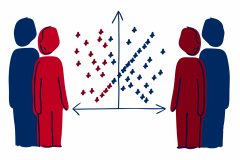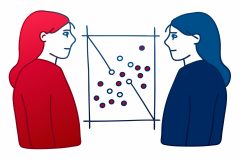Question More, Action Knowledge.
Remember, at QMAK, we don’t just teach; we empower. We don’t just inform; we inspire. We don’t just question; we act. Become a Gold Member, and let’s unlock your child’s full potential, one question at a time.
![]() Have you ever had an amazing day where everything just seemed to go your way?
Have you ever had an amazing day where everything just seemed to go your way?
Maybe you aced a test you didn’t study much for, won every game you played with your friends, or found a bunch of money on the ground.
On days like that, it can feel like you’re unstoppable and that your incredible luck will last forever!
But if you’ve ever experienced a streak of good luck like that, you’ve probably also noticed that things tend to even out over time.
After an exceptionally good day, you might have a few more ordinary or even not-so-great days that follow.
This is what we call “regression to the mean” – the idea that when something happens that’s way above or below average, the next thing that happens is more likely to be closer to the normal or average outcome.
Regression to the mean is all about how things tend to balance out and return to their typical levels after an extreme high or low.

It’s like when you’re playing a game and someone gets an unusually high (or low) score – the chances are that their next score will be closer to their normal, average level of performance.
This happens because many things in life are influenced by both skill and luck (or chance). When you have an exceptionally good or bad result, it’s often because luck played a bigger role than usual.
But since luck evens out over time, the next result is more likely to reflect your true, normal level of skill or ability.
Understanding regression to the mean is important for a few key reasons:
It helps us manage our expectations. After a really great success, it reminds us that we might not be able to keep up that same level of performance forever.

It prevents us from overreacting to one-time events. We learn not to get too excited (or disappointed) by a single extreme result, since things will likely balance out again soon.

It helps us appreciate average or consistent performance. We realize that steadily performing at a normal, reliable level is often more valuable than having occasional peaks and valleys.

It teaches us not to judge too quickly. We understand that first impressions or initial results don’t always tell the full story.

One of the best ways to understand regression to the mean is to experience it yourself.
Here are some fun activities to try:
Remember, regression to the mean is all about balance and evening out over time. While streaks of good or bad luck can happen, the key is to recognize them for what they are – temporary departures from the normal or average outcome. By understanding this concept, you’ll be better prepared to appreciate your successes while also maintaining a level head and realistic expectations.
Please note: We now have a longer article on Understanding Regression to the Mean in the “Mental Models” section of our website.
21 offers an absorbing examination of regression to the mean through its portrayal of MIT students attempting to beat the house at blackjack.
Through their journey from spectacular success to inevitable correction, students witness how extreme outcomes – even those achieved through skill and strategy – naturally tend to return to average over time.
The film demonstrates regression to the mean as the card-counting team’s initial winning streak attracts casino scrutiny and internal conflicts, showing how systems tend to self-correct when pushed to extremes.
As viewers follow Ben Campbell’s rise and fall, they learn how overconfidence in sustaining extreme success often accelerates the return to average outcomes.
Through its exploration of probability, risk, and human behavior in the high-stakes world of casino gambling, the film shows why understanding regression to the mean becomes crucial for making informed decisions in any system where chance plays a role.
(Verse 1)
On a lucky day, when everything goes right
You feel unstoppable, like you’re taking flight
But as time goes on, things start to even out
Regression to the mean, it’s what life’s about
(Chorus)
Regression to the mean, it’s a balancing act
Extremes don’t last forever, that’s a simple fact
Good luck, bad luck, they come and go
But in the end, it’s the average that shows
(Verse 2)
Skill and chance, they both play a part
In the outcomes we see, from the very start
When luck takes over, results can be extreme
But regression to the mean, brings us back to the scene
(Bridge)
Managing expectations, not overreacting too
Appreciating consistency, in all that we do
Not judging too quickly, based on just one try
Regression to the mean, it’s a principle to live by
(Chorus)
Regression to the mean, it’s a balancing act
Extremes don’t last forever, that’s a simple fact
Good luck, bad luck, they come and go
But in the end, it’s the average that shows
(Verse 3)
Flipping coins, shooting hoops, guessing numbers too
Hands-on learning, helps us see the truth
Streaks may happen, but they don’t define
The overall picture, the average over time
(Bridge)
So when you’re riding high, on a wave of success
Remember regression to the mean, it’s a concept to address
And when you’re feeling low, after a streak of bad
Know that balance will return, it’s not forever sad
(Chorus)
Regression to the mean, it’s a balancing act
Extremes don’t last forever, that’s a simple fact
Good luck, bad luck, they come and go
But in the end, it’s the average that shows
(Outro)
Embrace the ebb and flow, the highs and lows of life
Regression to the mean, it cuts through like a knife
Reminding us to stay grounded, no matter the scene
And appreciate the balance, of the in-between!
Remember, at QMAK, we don’t just teach; we empower. We don’t just inform; we inspire. We don’t just question; we act. Become a Gold Member, and let’s unlock your child’s full potential, one question at a time.